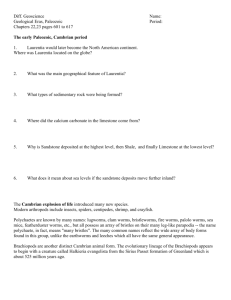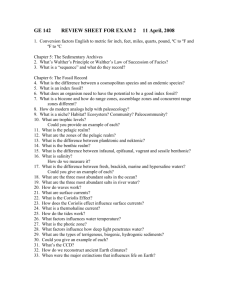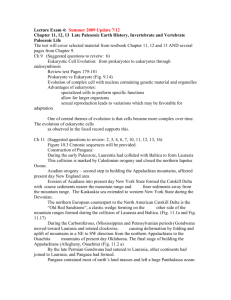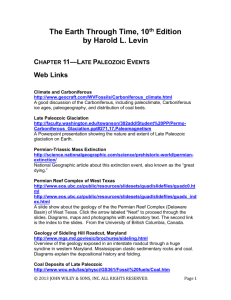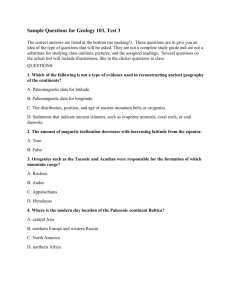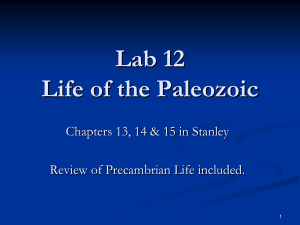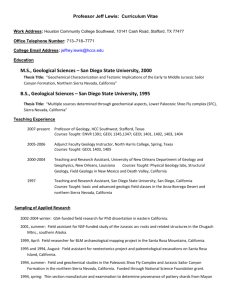Paleozoic California
advertisement
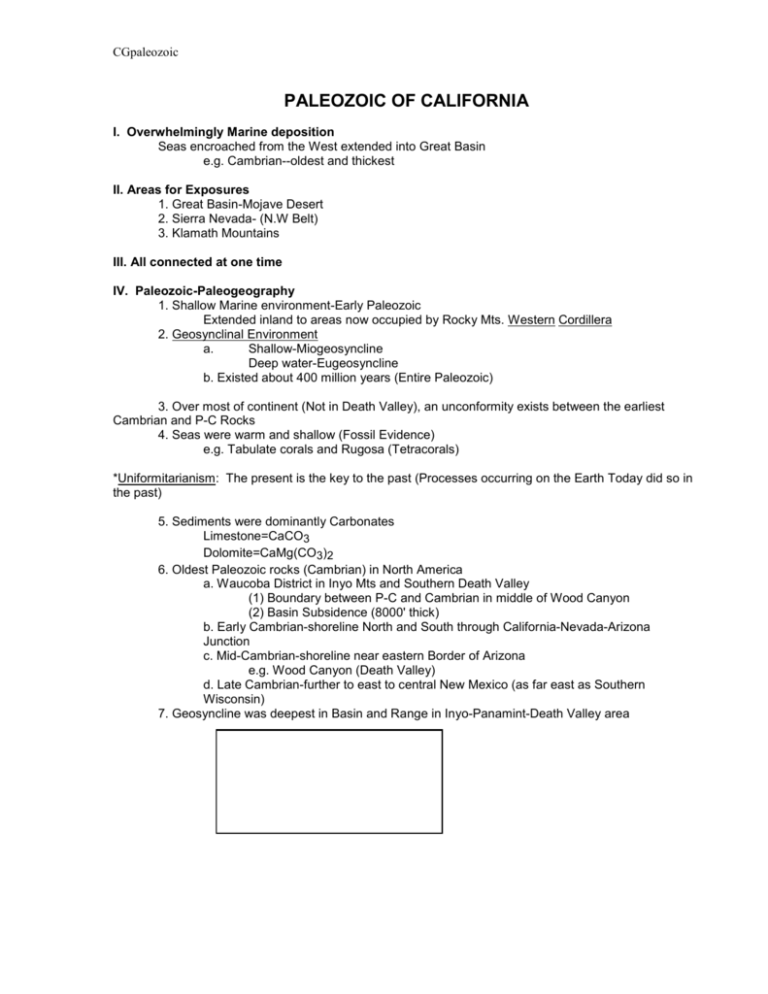
CGpaleozoic PALEOZOIC OF CALIFORNIA I. Overwhelmingly Marine deposition Seas encroached from the West extended into Great Basin e.g. Cambrian--oldest and thickest II. Areas for Exposures 1. Great Basin-Mojave Desert 2. Sierra Nevada- (N.W Belt) 3. Klamath Mountains III. All connected at one time IV. Paleozoic-Paleogeography 1. Shallow Marine environment-Early Paleozoic Extended inland to areas now occupied by Rocky Mts. Western Cordillera 2. Geosynclinal Environment a. Shallow-Miogeosyncline Deep water-Eugeosyncline b. Existed about 400 million years (Entire Paleozoic) 3. Over most of continent (Not in Death Valley), an unconformity exists between the earliest Cambrian and P-C Rocks 4. Seas were warm and shallow (Fossil Evidence) e.g. Tabulate corals and Rugosa (Tetracorals) *Uniformitarianism: The present is the key to the past (Processes occurring on the Earth Today did so in the past) 5. Sediments were dominantly Carbonates Limestone=CaCO3 Dolomite=CaMg(CO3)2 6. Oldest Paleozoic rocks (Cambrian) in North America a. Waucoba District in Inyo Mts and Southern Death Valley (1) Boundary between P-C and Cambrian in middle of Wood Canyon (2) Basin Subsidence (8000' thick) b. Early Cambrian-shoreline North and South through California-Nevada-Arizona Junction c. Mid-Cambrian-shoreline near eastern Border of Arizona e.g. Wood Canyon (Death Valley) d. Late Cambrian-further to east to central New Mexico (as far east as Southern Wisconsin) 7. Geosyncline was deepest in Basin and Range in Inyo-Panamint-Death Valley area CGpaleozoic 8. Ordovician a. Same areas b. dolomite and light gray Mid-Ordovican Eureka Quartzite--widespread easily recognized; found in California and Western Nevada c. Best exposures found in isolated remnants in Sierra Nevada and Klamaths mts. 9. Silurian and Devonian e.g. limestones and dolomites 10. Mississippean (Mitchell Caverns in Providence mountains) e.g. limestones 11. Late Miss.--Pennsylvanian seas become shallower and more muddy (shales) -uplift of land to east --mountain building=Orogenic activity 12. Penn.--Permian coarser sediments along with increasing Volcanism and unconformities a. indicated orogenic activity in Basin-Range, Sierra Nevada and Klamaths Areas b. Granites in Area dated as Permian 13. Coast ranges and Peninsula Range areas--Paleozoic sediments were eugeosynclinal but little history preserved CGpaleozoic 14. Eastern Mojave Desert a. Only find Cambrian and late Paleozoic sediments and strata Ordovician and Silurian rocks are absent 15. South Western Mojave a. no lower Paleozoic and Devonian b. Mississippean and Permian represented 16. Gaps a. Land above sea level b. uplift and erosion (remove sediments) 17. Coast, Transverse and Peninsular Ranges a. Scant fossil remains b. Quartzites, schists, marbles c. Furnace limestone marble---San Bernardino mountains about 4500ft thick brachiopods, horn corals, and Foraminifera (Miss-Penn in age) d. Sur Series-marbles, schist, quartzsites in coast ranges late Paleozoic sediments (Metamorphosed in Mesozoic) e. Remnants of Paleozoic materials around Point Reyes west side of San Andreas fault f. San Gabriel mountains Granite about 245 million years old 18. Sierra Nevada (N.W. Belt) a. mostly granite batholiths (Mesozoic in age) b. left over Paleozoic rocks called remnants--isolated rocks are called Roof Pendants e.g. Schists, limestones, quartizites, slate c. Mount Morrison Area thickest and best known section -about 32,000 ft (1) Lower portion-Ordovician rocks (2) upper portion fossiliferous--Penn and Permian strata d. Calaveras Formation Western foothills of Sierra Nevada East of Mother Lode Fault zone (1) all metamorphosed but they were, shales, dark sandstones, chert, minor limestone and submarine volcanic rock (2) Northern end--metamorphosed strata Silurian-Permian in age (fossil beds) (3) Angular unconformities found between a. Silurian and Devonian b. Permian and Triassic **uplift and erosion--orogenic activity CGpaleozoic 19. Klamath Mountains a. abundant Paleozoic strata b. Three Arc--shaped zones Eastern Klamaths 25,000 ft. of Marine Sedimentary rock (Ordovician--Permian) Rocks are metamorphosed but were originally graywacke, cherts, conglomerates, rhyolites and basalts c. Two periods of orogenic activity (unconformities) (1) first in Devonian (2) Lake Penn.throughTriassic implies emergence of land and mountain building


